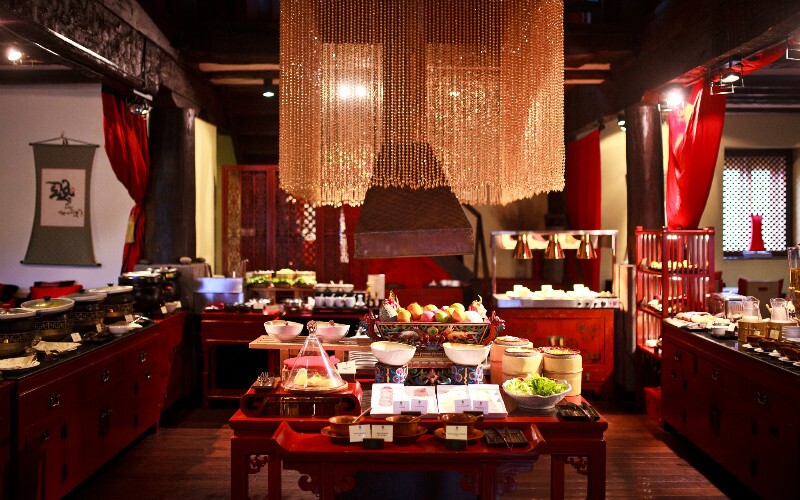A pleasant meal can make a trip better. If you haven't experienced restaurants in China, this article will help you get prepared for what to expect.
High-End Restaurants — Quiet, Good View
In China, high-end restaurants look very luxurious and ornate. The decoration is often antique (-style) with traditional Chinese features. Foreign-style establishments aim to be sophisticated. The food is over-priced — you pay for the environment.
The Establishment
 A private room in Quanjude Restaurant, Beijing
A private room in Quanjude Restaurant, BeijingCustomers who go to such high-end restaurants are usually wealthy and more refined Chinese. Usually they dress up, and go for an important reason — proposal, birthday, anniversary, or some important business deal. They don't go there often, usually once in a few months.
Location: High-end restaurants usually take prime locations in the city center: at the top of a high building, or with an open balcony over some scenic vista, or in a quiet corner of the city for peaceful dining. They generally offer the best views of the city.
Environment: The decoration is typically elegant and well-designed, sometimes ostentatious, either Foreign-style or traditional Chinese-style. Smoking is still allowed at some high-end restaurants (all but prohibited in Beijing now), but you can escape it with a private room.
 A wooden lazy suzy in the middle of a table
A wooden lazy suzy in the middle of a tableFacilities: Purpose-designed buildings include parking lots and centrally-controlled air-conditioning. In Chinese-style restaurants the table is usually round with a large lazy Suzy in the middle, which is convenient for you to taste each dish. The bathrooms are clean, often with Western seated toilets (soap and toilet paper provided!), and some private eating rooms have their own private bathroom.
The Eating Experience
Menu: The name of every dish sometimes doesn't explain what it actually is, so the menu usually has pictures. Most high-end restaurants have an English menu, though you may still need a guide/interpreter to ask about the food, as in some places staff will not be able to answer adequately in English.
 Interesting tableware
Interesting tablewareFood: The ingredients are fresh and some are very expensive. You can't see common dishes at high-end restaurants, such as fried egg with tomatoes. The presentation of dishes is typically very beautiful and elegant.
Tableware: The tableware is often traditionally-styled, high-quality, wooden, china, bamboo, or earthen. You will probably still be stuck with chopsticks though, unless it's a Western-style restaurant. You may ask for a knife and fork, and some establishments will have them; they will usually have Western spoons.
Service: Staff are always plentiful and very polite. You shouldn't have problems with service, though making yourself understood with only English may be a difficulty. After your meal, the waiter/waitress will kindly ask whether you are satisfied with your meal, and you won't need to get up for anything, even to pay the bill.
Average price per person: over 300 yuan (tipping is not expected) — though the price is quite expensive, the dishes may be small or not to your taste.
Mid-Range Restaurants — Popular, Noisy
Mid-range restaurants can be found in all cities and are very popular among Chinese. Usually you have to call the restaurant to make a reservation, though evenings are busier than afternoons.
The Establishment
 Simple but elegant decoration
Simple but elegant decorationCustomers: When Chinese dine together, with families, with colleagues, or with friends, they often go to mid-range restaurants. So the tables are usually quite big (seating 10 or 12), and round, and also usually with a lazy Suzy in the middle, convenient for group meals.
Location: Usually near busy streets or somewhere easy to access, you can see the name of the restaurant displayed prominently, usually as a big, brightly-lit banner over the entrance.
Environment: The main eating area may seem very crowded, smoky (most allow smoking except in Beijing), and noisy for a Westerner. Private rooms are quieter, but the noise and smoke may not be completely cut out.
Facilities: Usually with inadequate parking, air-conditioning may be by old or difficult-to-adjust units, and the restrooms usually do not have toilet paper and only have squat toilets.
The Eating Experience
 Mid-range restaurants serve dishes with good portions.
Mid-range restaurants serve dishes with good portions.Menu: Some restaurants have pictures on the menu, and not many restaurants have (correct) English names for every dish. You will probably want a guide/interpreter if your Chinese is not good.
Food: Portions are a decent size (though dishes are as little as 50% of American-size meals); no nouvelle cuisine (big plates with a morsel of food) is served. There are usually some (free) appetizers before the meal, usually pickled vegetables, wood ear mushrooms, peanuts, seeds, or some other snack, and (free) tea.
Tableware: The tableware usually consists of chopsticks, a Chinese soup spoon, a rice bowl, a side plate (for bones, etc.), a Chinese tea cup, a small glass (for other beverages), and a tiny sauce dish. It is usually supplied by a crockery sanitizing company in transparent shrink-wrap, which you have to "pop" to open, and plastic chopsticks come in a paper sleeve. Some restaurants have their own tableware laid out for you on the table.
Service: Staff are limited, and usually insufficient when the restaurant is busy, so it may take some time to get served. But you can order tea or juice first with snacks and chat while you wait (20 minutes is usual at busy times). The appetizers are served very quickly.
Average price per person: around 100 yuan (cheaper in provincial cities/towns)
Small Street Restaurants — Crowded, Cheap
You can see such restaurants nearly everywhere, from small towns to every urban block. Usually only one floor and easy to access, the area is not very big, but the space is used to the maximum, so they can look cramped and cluttered.
The Establishment
Customers are usually working-class locals, low-paid workers, students, etc. They don't want to cook at home, or don't want to go to the school dining hall, so they go to such restaurants for a meal. Even if the seats are all occupied, you'll soon have a seat, as the clientele eat quickly before going back to work, school, etc.
Location: These restaurants are set by the roadside, where rent is cheap.
Environment: Decoration is very simple (or non-existent), sometimes looking dirty and rundown, but this translates into cheap prices. Customers may smoke, spit, belch, shout, and (try to) push in at will. Bowls and food are left on the tables, which are often not cleaned properly. Mind your elbows.
Facilities: There are usually no bathrooms, and no allocated parking. Some don't have air-conditioners, but have big fans on in the summer. The tables and stools may be very short: some stools are only 20cm (8") high!
The Eating Experience
Menu: The menu is usually shown on the wall (no English), sometimes with photos (though they may not be the same as what is served). Order what you want (and pay) first, then go and find a seat.
Food: The food is very simple and in good portions.
 Disinfected tableware
Disinfected tablewareTableware is simple: crockery/stainless-steel bowls and plates, sometimes disinfected tableware from a dedicated company. Chopsticks are often disposable bamboo ones (watch out for splinters). Most street restaurants offer paper/polystyrene cartons for take-out.
Service: Sometimes there are no waiters/waitresses. That's why you need to order the food at the cashier desk first and sometimes you need to collect your food from the server or food hatch. Sometimes the cook or cashier doubles as the one who cleans up the tables, so used bowls mount up at busy times. Staff won't understand English, and sometimes the only spoken Chinese is a local dialect, not standard Mandarin.
Average price per person: 30 yuan (less in provincial areas)
Snack Stalls — Simple Menu, Quick Service
In China you can see many snack stalls on the streets. The food is typically served from a tricycle or a table (holding heating equipment) with a huge umbrella. These are very popular for breakfast or evening snacks (宵夜 xiāoyè /sshyaow-yeah/), or for snacks at weekends.
The Stall
 A Chinese bun stall in Guangzhou
A Chinese bun stall in GuangzhouCustomers are usually local people going to work or school, or relaxing in the evening. If the stall is in a snack street, then the customers may be travelers who want to taste some delicious local snacks.
Location: This kind of "restaurant" is usually set up in front of or near schools, workplaces, and popular thoroughfares. In some cities, the government has set a fixed position for them — a snack street.
Decoration: Usually the only decoration is a big name card in front of the stall saying what is sold.
Facilities: The facilities may be only a trash can beside the stall. But if there is a fixed snack street, short tables and stools may be available, but not many. Some night stalls may have their own area to set up tables and chairs.
The Eating Experience
Menu: The menu is one-dimensional — at most a few options, such as dumplings, steamed buns, or barbecued skewers of meat/veg.
 A roadside fried snack stall in Guilin
A roadside fried snack stall in GuilinFood: The food is very simple and you can usually see all of what's on offer at the stall. Be particularly wary of food hygiene. Avoid foods that haven't been freshly cooked. Ice may have been made from "unpotable" tap water!
Tableware: There is usually just disposable bowls and chopsticks, and plastic bags for take away. But some night or food street stalls may have stainless-steel bowls and dishes, or vacuum wrapped sets from a crockery sanitizing company.
Service: Just the vender usually. He/she will finish your order as quickly as possible, pack it for you, and take your money, before moving onto the next customer. But at night stalls / snack streets, there is usually one waiter/waitress to clean up the tables. Definitely no fluent English, but some bosses may have learned a few simple words to tell you the price in touristy areas.
Average price per person: 5 yuan for a snack; 10+ yuan for breakfast / supper









